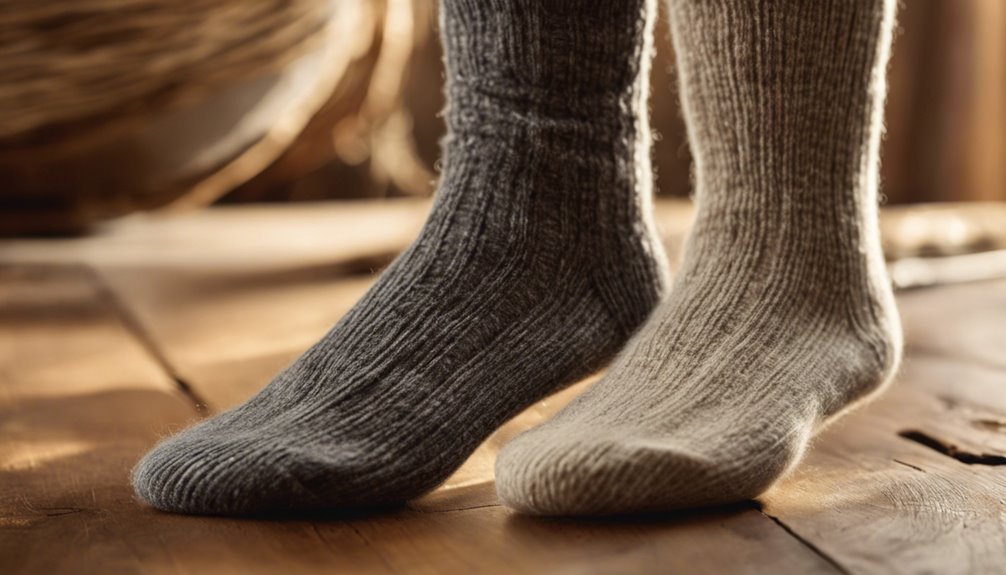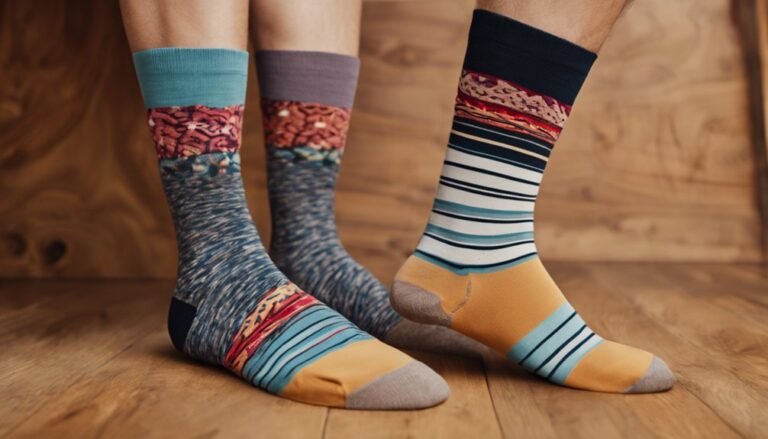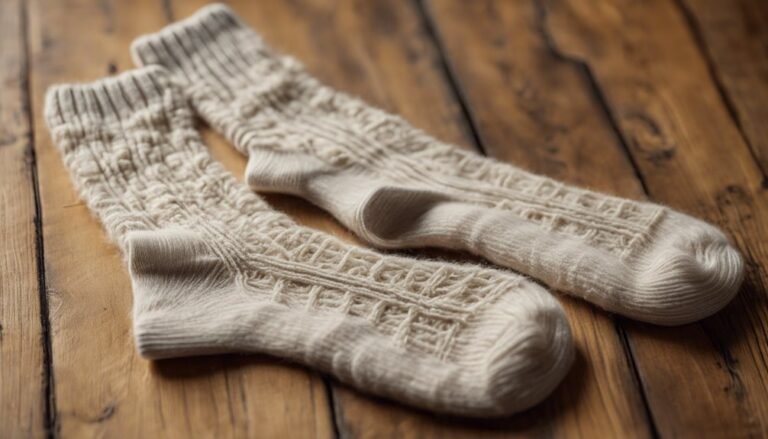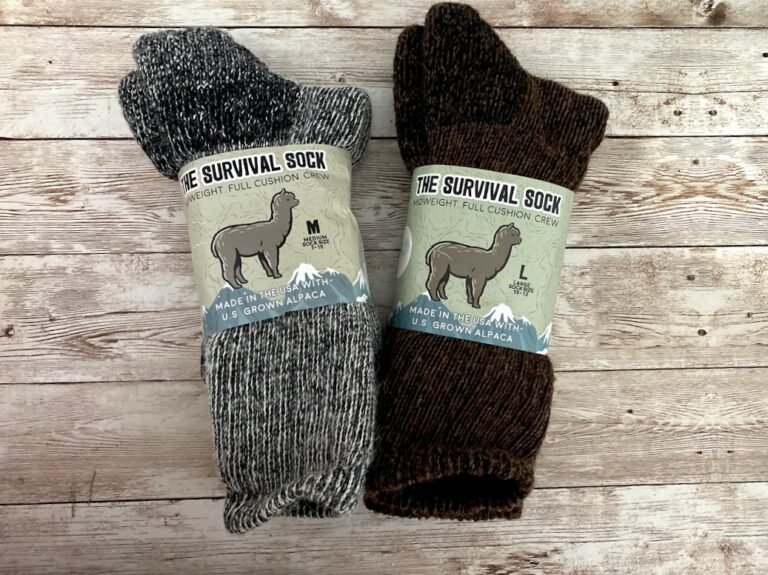Merino Wool vs. Cashmere Socks: Which One Is Warmer?
When considering warmth, Merino wool socks generally outperform cashmere. Merino wool's unique fiber structure traps air, boosting insulation efficiency and keeping you warm in cold conditions. It also excels in moisture-wicking, preventing dampness that can lead to chilling. While cashmere offers exceptional softness and warmth, it doesn't regulate temperature as effectively in harsh weather. Choosing the right material depends on your specific needs, and there's more to explore about their characteristics and care.
Understanding Merino Wool: Characteristics and Benefits

When you consider the qualities of Merino wool, it's essential to understand its unique characteristics that set it apart from other fabrics. Merino characteristics include fine fibers that create a soft texture, reducing itchiness commonly associated with wool. This fabric also boasts excellent moisture-wicking properties, drawing sweat away from your skin to keep you dry. Additionally, its natural elasticity guarantees a snug fit without compromising comfort.
The merino benefits extend beyond comfort; it provides exceptional temperature regulation, keeping you warm in cold conditions and cool when it's hot. Its breathability and odor resistance allow for extended wear, making it ideal for active lifestyles. Overall, choosing Merino wool translates to a versatile and high-performance option, enhancing your freedom to move effortlessly.
Exploring Cashmere: Unique Qualities and Advantages
Although cashmere is often celebrated for its luxurious feel, its unique qualities extend well beyond mere softness. Cashmere fibers are finer and lighter than many other wool types, which means they offer exceptional cashmere softness without overwhelming bulk. This delicate texture not only enhances comfort but also contributes to a refined aesthetic.
Moreover, cashmere warmth is remarkable; it provides excellent insulation while remaining breathable. This balance allows you to stay warm without overheating, making cashmere socks ideal for various climates. Additionally, cashmere's natural elasticity guarantees a snug fit, enhancing overall wearability. With its unique combination of softness, warmth, and durability, cashmere stands out as an exceptional choice for those seeking comfort and style in their sock collection.
Thermal Insulation: Comparing Warmth of Merino Wool and Cashmere
While both merino wool and cashmere are prized for their insulating properties, they differ markedly in performance and application. Merino wool boasts superior thermal properties, making it an excellent choice for cold-weather gear. Its unique fiber structure traps air, enhancing insulation efficiency and keeping your feet warm even in wet conditions. On the other hand, cashmere, while luxurious and soft, offers less insulation efficiency. It provides warmth but may not perform as well in extreme temperatures. Furthermore, merino wool's resilience and ability to wick moisture contribute to its overall thermal effectiveness, offering a balance of warmth and comfort. When choosing between the two, consider how each material's thermal properties align with your specific needs for warmth.
Breathability and Moisture Management: Which Material Performs Better?

When it comes to breathability and moisture management, both merino wool and cashmere offer distinct advantages. You'll want to take into account their moisture-wicking properties, temperature regulation capabilities, and odor resistance factors to determine which material suits your needs better. Understanding these elements is essential for optimizing comfort and performance in your sock choice.
Moisture Wicking Properties
Understanding the moisture-wicking properties of merino wool and cashmere socks is essential for anyone seeking comfort during various activities. Merino wool excels in moisture absorption, quickly drawing sweat away from your skin, which enhances breathability. This property keeps your feet dry, minimizing the risk of blisters and discomfort. In contrast, cashmere's moisture management is less effective; it can retain moisture, leading to a clammy feel. Additionally, merino wool helps with temperature control, maintaining a comfortable microclimate for your feet. It effectively regulates heat, ensuring you stay warm in colder conditions while remaining cool when it's warmer. Ultimately, if you value moisture-wicking capabilities for active pursuits, merino wool is the superior choice.
Temperature Regulation Capabilities
Moisture-wicking properties naturally lead to a discussion on temperature regulation capabilities, as both factors greatly influence comfort during wear. When considering Merino wool and cashmere, you'll find distinct differences in thermal comfort:
- Breathability: Merino wool excels at allowing air circulation, promoting temperature consistency.
- Moisture Management: Merino absorbs moisture without feeling wet, while cashmere retains moisture, impacting comfort.
- Insulation: Cashmere offers luxurious warmth, but can lead to overheating in variable conditions.
- Adaptability: Merino wool adjusts to your body temperature, ensuring you stay comfortable throughout the day.
Odor Resistance Factors
Odor resistance in socks is considerably influenced by the materials' breathability and moisture management. Merino wool employs natural odor resistance mechanisms, effectively wicking away moisture while allowing air circulation. This reduces the likelihood of bacterial growth, which is often responsible for odors. In contrast, cashmere, while luxurious, tends to retain moisture more, leading to an increased possibility of odor retention. When conducting an odor retention comparison, you'll find that Merino wool socks generally perform better due to their superior moisture management properties. Consequently, if you're seeking socks that keep your feet fresher for longer, choosing Merino wool over cashmere is a practical decision, ensuring you enjoy both comfort and odor resistance throughout your day.
Durability and Care: Longevity of Merino Wool vs. Cashmere Socks
When comparing the durability of Merino wool and cashmere socks, it's crucial to take into account their respective fibers and how they withstand wear over time. Merino wool typically offers superior resilience, while cashmere, though luxurious, may require more careful handling. Understanding the proper care instructions for each material can greatly influence their longevity in your sock drawer.
Durability Comparison
Although both Merino wool and cashmere socks offer a premium feel, their durability and care requirements differ greatly. When considering longevity, you'll find a significant lifespan comparison:
- Merino Wool: Highly resilient, withstands wear and tear effectively.
- Cashmere: Softer but prone to pilling, making it less durable over time.
- Usage Frequency: Merino socks can handle everyday use better than cashmere.
- Environmental Factors: Merino wicks moisture, reducing stress on fibers, while cashmere may degrade faster in damp conditions.
In essence, if you value freedom in durability and want socks that last longer with minimal fuss, Merino wool is your best bet. Cashmere, while luxurious, may require more careful handling to maintain its appearance and integrity.
Care Instructions
While both Merino wool and cashmere socks offer distinct advantages, understanding their care instructions is essential for maximizing their longevity. Merino wool generally requires more forgiving washing techniques; you can machine wash it on a gentle cycle with cold water. It's also less prone to shrinkage, making it easier to maintain. On the other hand, cashmere demands a more delicate approach. Hand washing in cool water with a mild detergent is recommended, followed by laying flat to dry. Avoid using fabric softeners, as they can damage the fibers. Regularly following these care instructions will help you enjoy your socks longer, preserving their warmth and softness while ensuring they remain a staple in your wardrobe.
Comfort and Fit: How Each Material Feels on Your Feet
As you slip on a pair of socks, the immediate sensation of the fabric against your skin can greatly influence your comfort throughout the day. When comparing Merino wool and cashmere, each offers unique characteristics that affect the softness sensation and snug fit.
- Merino Wool: Known for its breathable, moisture-wicking properties, it provides a soft touch while conforming snugly around your foot.
- Cashmere: Offers an unparalleled softness sensation, feeling luxurious against your skin, but it may lack the same level of stretch and support.
- Durability: Merino wool generally outlasts cashmere, maintaining its shape and snug fit longer.
- Temperature Regulation: Both materials adjust to your body heat, ensuring comfort in varying conditions.
Choosing the right fabric can considerably enhance your experience.
Price Point: Evaluating the Cost of Merino Wool and Cashmere Socks
When considering the price point of Merino wool and cashmere socks, it's essential to recognize the significant differences in cost associated with each material. Cashmere socks typically fall on the higher end of the price spectrum, often reflecting the luxurious nature of the fiber. Conversely, Merino wool socks tend to be more budget-friendly, offering a compelling value comparison for those seeking warmth without breaking the bank. While cashmere provides unparalleled softness, the durability and moisture-wicking properties of Merino wool make it an excellent choice for everyday wear. Ultimately, your budget considerations will guide your decision. If you value luxury and are willing to invest, cashmere might be your pick; however, Merino wool offers a practical, cost-effective alternative.
Frequently Asked Questions
Are Merino Wool and Cashmere Socks Suitable for Sensitive Skin?
If you've got sensitive skin, you might wonder about potential fabric irritation. Merino wool is often gentler, while cashmere's softness can be soothing. Ultimately, it depends on your unique skin's response to each fabric.
Can I Wash Merino Wool and Cashmere Socks in a Washing Machine?
You can wash both Merino wool and cashmere socks in a washing machine, but follow specific care instructions. Use gentle cycles and cold water. Proper washing methods guarantee they maintain their softness and longevity.
How Do Merino Wool and Cashmere Socks Compare for Outdoor Activities?
When engaging in outdoor activities, you'll find Merino wool boasts a breathability comparison of 70% more than cashmere, offering superior insulation properties. This makes it ideal for dynamic movements and temperature regulation during your adventures.
Which Socks Are Better for Diabetic Feet, Merino Wool or Cashmere?
When considering foot care for diabetes, merino wool's moisture-wicking and temperature-regulating properties can enhance circulation. Cashmere is softer but may not provide the same benefits. Choose wisely to support your foot health and comfort.
Do Merino Wool and Cashmere Socks Have Any Odor Resistance?
When it comes to odor resistance, both merino wool and cashmere excel in moisture management and odor absorption. You'll find that merino wool tends to outperform cashmere slightly, keeping your feet fresher longer.







